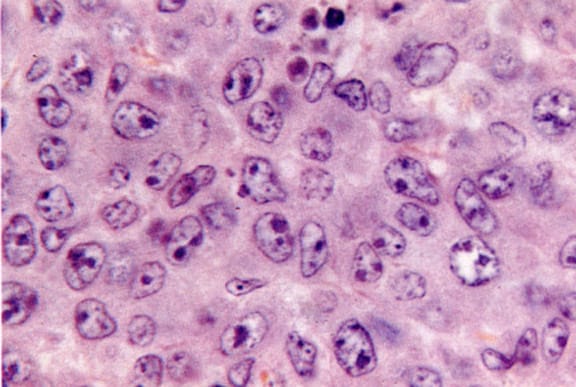It was January 2003, the New Year passed. It was supposed to be a happy, and healthy Year. The New Year can be your second chance. A chance to make yourself a better person by strengthening relationships, setting goals, and striving for your dreams. Anxiously awaiting a call back from the pulmonary doctor my Father went to see about 2 hours earlier, I tried to work, but could not concentrate. I had a nervous feeling in my stomach since the night before when I realized my Dad was very sick. He sounded out of breath when speaking on the phone with him. I could hear him coughing, and sensed a weakness within him. All I could do was wait until after he saw the doctor the next day.
The word Lymphoma was foreign to me, but sent a shock so piercing through my body that I went numb. The only words that came out of my mouth when I was speaking to the doctor were "the what?" With slight hesitation she asked me if my Father shared his health issues with me. I replied, "Apparently Not!" I could not get more information until my Father gave permission. Though Lymphoma was an unknown to my sisters and me, it was not foreign to my Father who was diagnosed with it a year before. At that point he did not need treatment and because there is no cure for Mantle Cell Lymphoma, he hoped for a trial drug when the time came. Since we had lost my Mother to cancer in 1995, my Father wanted to spare us this devastating news until absolutely necessary.
At this moment, the disease that was lying still in his body, decided it was time to erupt. A family meeting would be scheduled with the cancer specialist my Dad had been seeing all year. As my younger sister, her husband, my Father's girlfriend and I gathered around my Father's hospital bed, it seemed surreal. The only option was to give my Father prednisone and follow with a chemotherapy treatment. (C.H.O.P.) Since he was so weak, there was a chance of complications that could put his life in danger. We didn't have much of a choice.
Almost every bad thing that could have happened did, plus situations that even confused the doctors. My Father ended up in the Intensive care unit 2 times. The second time he had to have a breathing tube inserted. In the meantime his kidneys were failing and he needed dialysis. On top of this, he developed a necrosis of the feet and upper lip. This caused gangrene to set in. Part of his lip died due to this lack of blood flow. There was a chance he would have to have portions of his feet amputated. After removing the dead tissue on my Father's lip his speech became impaired. The circulation problems affected his hands and he didn't have the dexterity he once did.
Based on the experience of watching my Mother wither away from cancer, I knew my survival skills would set in. You have to step out of your comfort zone and become the pillar of strength that your parent's always were to you. You become the optimist when you are feeling pessimistic. You put on a brave face when all you want to do is cry. You become the caregiver when you are used to being cared for. You become the advocate and speak with conviction when before you were the listener. You become the educator by researching the killer disease when before you were the student. Before was when you were the child and your parents were your teachers. They laid a canvas for you and with their guidance and nurturing you began to paint the picture. The picture of your life. If you were lucky like I was, you were given the tools and teachings you needed so when a situation like this arose you were able to rise up and orchestrate to the best of your ability.
The hardest part was I couldn't do anything about the physical destruction of my Father's body. Only weeks before he looked so strong, and healthy. Now he couldn't walk, and could not speak with the articulation of the intelligent man he was. He could no longer eat, and a feeding tube was inserted. How do you convince a man in this state, that has been through so much pain and suffering, that he should be happy to be alive? It is selfish in part because you want him alive for you. Was any part of this good? For me it was day-by-day survival. For my Father it was day-by-day survival. How ironic. One of us was healthy and the other near death, yet the survival skills were needed by both. I felt like every ounce of my being was sucked out of me. I felt like I had to live for both of us.
After a while you see how tired, how sad, and how lifeless your loved one becomes and you accept that their fight may be over. It should be their choice to live or not. Just seeing my Dad was enough for me, but it wasn't enough for him. I knew he hated, that we had to see him like this. There must come a point in time when you are so sick, that you give up hope, and do not want to live as you are. My Father had been SELFLESS his entire life. At this moment in time the choice was his. We owed him the right to surrender. He surrendered on April 8, 2003 and his wonderful, strong soul rose to the heavens where he was reunited with his beautiful bride. There is a missing piece in my heart and soul where my parents once were. A void that can never be filled. I have some solace in knowing they are not suffering, and are at peace in each others' arms. I am thankful for the time I had with them.
The word Lymphoma was foreign to me, but sent a shock so piercing through my body that I went numb. The only words that came out of my mouth when I was speaking to the doctor were "the what?" With slight hesitation she asked me if my Father shared his health issues with me. I replied, "Apparently Not!" I could not get more information until my Father gave permission. Though Lymphoma was an unknown to my sisters and me, it was not foreign to my Father who was diagnosed with it a year before. At that point he did not need treatment and because there is no cure for Mantle Cell Lymphoma, he hoped for a trial drug when the time came. Since we had lost my Mother to cancer in 1995, my Father wanted to spare us this devastating news until absolutely necessary.
At this moment, the disease that was lying still in his body, decided it was time to erupt. A family meeting would be scheduled with the cancer specialist my Dad had been seeing all year. As my younger sister, her husband, my Father's girlfriend and I gathered around my Father's hospital bed, it seemed surreal. The only option was to give my Father prednisone and follow with a chemotherapy treatment. (C.H.O.P.) Since he was so weak, there was a chance of complications that could put his life in danger. We didn't have much of a choice.
Almost every bad thing that could have happened did, plus situations that even confused the doctors. My Father ended up in the Intensive care unit 2 times. The second time he had to have a breathing tube inserted. In the meantime his kidneys were failing and he needed dialysis. On top of this, he developed a necrosis of the feet and upper lip. This caused gangrene to set in. Part of his lip died due to this lack of blood flow. There was a chance he would have to have portions of his feet amputated. After removing the dead tissue on my Father's lip his speech became impaired. The circulation problems affected his hands and he didn't have the dexterity he once did.
Based on the experience of watching my Mother wither away from cancer, I knew my survival skills would set in. You have to step out of your comfort zone and become the pillar of strength that your parent's always were to you. You become the optimist when you are feeling pessimistic. You put on a brave face when all you want to do is cry. You become the caregiver when you are used to being cared for. You become the advocate and speak with conviction when before you were the listener. You become the educator by researching the killer disease when before you were the student. Before was when you were the child and your parents were your teachers. They laid a canvas for you and with their guidance and nurturing you began to paint the picture. The picture of your life. If you were lucky like I was, you were given the tools and teachings you needed so when a situation like this arose you were able to rise up and orchestrate to the best of your ability.
The hardest part was I couldn't do anything about the physical destruction of my Father's body. Only weeks before he looked so strong, and healthy. Now he couldn't walk, and could not speak with the articulation of the intelligent man he was. He could no longer eat, and a feeding tube was inserted. How do you convince a man in this state, that has been through so much pain and suffering, that he should be happy to be alive? It is selfish in part because you want him alive for you. Was any part of this good? For me it was day-by-day survival. For my Father it was day-by-day survival. How ironic. One of us was healthy and the other near death, yet the survival skills were needed by both. I felt like every ounce of my being was sucked out of me. I felt like I had to live for both of us.
After a while you see how tired, how sad, and how lifeless your loved one becomes and you accept that their fight may be over. It should be their choice to live or not. Just seeing my Dad was enough for me, but it wasn't enough for him. I knew he hated, that we had to see him like this. There must come a point in time when you are so sick, that you give up hope, and do not want to live as you are. My Father had been SELFLESS his entire life. At this moment in time the choice was his. We owed him the right to surrender. He surrendered on April 8, 2003 and his wonderful, strong soul rose to the heavens where he was reunited with his beautiful bride. There is a missing piece in my heart and soul where my parents once were. A void that can never be filled. I have some solace in knowing they are not suffering, and are at peace in each others' arms. I am thankful for the time I had with them.




















